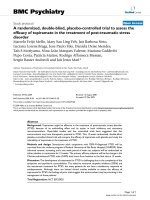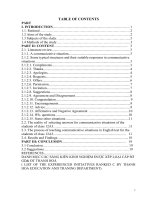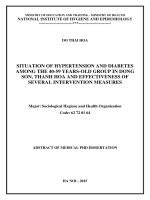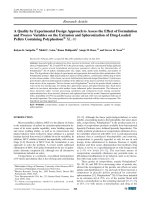Geoelectrical investigations on coastal aquifers to assess the saline water intrusion in Nghi Son, Thanh Hoa
Bạn đang xem bản rút gọn của tài liệu. Xem và tải ngay bản đầy đủ của tài liệu tại đây (927.13 KB, 8 trang )
Journal of Marine Science and Technology; Vol. 17, No. 4B; 2017: 115-122
DOI: 10.15625/1859-3097/17/4B/12999
/>
GEOELECTRICAL INVESTIGATIONS ON COASTAL AQUIFERS
TO ASSESS THE SALINE WATER INTRUSION
IN NGHI SON, THANH HOA
Nguyen Trong Vu*, Nguyen Ba Duan, Tran Dinh Tung
Institute of Geophysics, VAST
*
E-mail:
Received: 9-11-2017
ABSTRACT: This paper presents the results of geoelectrical investigations for delineation of
the aquifers and determination the hydrogeological situation of the water bearing in Nghi Son
economic zone. Following the geophysical investigations and the stratification of geological
formation, the boundary between fresh and saline water is determined in study area. The
geoelectrical measurements indicate that the saline water intrusion within the Pleistocene aquifer
occurs along the coastline of the Northeast part of Nghi Son economic zone. The values of
formation resistivity below 20 Ωm imply that the water bearing is brackish or saline water. The
geophysical results are corresponding to borehole nearby profiles. The geoelectrical methods have
proved to be appropriate tools to investigate 2D geological structure in the coastal areas that have
low resistivity of subsurface.
Keywords: Geoelectrical investigations, apparent resistivity, saline water intrusion.
INTRODUCTION
The economic zone, Nghi Son - Thanh
Hoa, is an important industry park in North
Centre of Vietnam. It stretches over natural
area of twelve communes belonging to Tinh
Gia district, Thanh Hoa province. Requiring a
high amount of water demand, Nghi Son
economic zone is facing the lack of fresh water
for living and production. Almost all the water
supply for Nghi Son economic zone comes
from surface water resources such as rain fall,
rivers and lakes. The ground water only exists
with a narrow area for both Holocene and
Pleistocene aquifers. The ground water is only
extracted in family water wells. The
unprompted extraction of ground water on
small scale may pollute the aquifers due to the
saline water intrusion [1, 2].
Saltwater intrusion is the movement of
saline water into freshwater aquifers. The
detection
and
quantification
of
this
phenomenon is the target of geoelectrical
methods in coastal environment. Geoelectrical
methods have proved to be efficient tools for
geoenvironmental investigations on saltwater
intrusion in coastal areas because the salt
content of water dominates the electrical
conductivity of the sediments [3, 4]. Based on
geoelectrical investigations, the structure of
aquifers and the transition zone between
fresh/saline water can be delineated. Note that
geoelectrical measurements do not directly
detect the saline water but they can measure the
characteristic
increase
of
formation
conductivity, which is caused by the saltwater
intrusion phenomenon.
The main water bearing formations in Nghi
Son economic zone are Holocene and
115
Nguyen Trong Vu, Nguyen Ba Duan,…
Pleistocene aquifers. Following previous
researches, the Holocene is a poor water
bearing formation while the high potential
Pleistocene aquifer contains both fresh and
saline water. To delineating the geological
structure and to assess the hydrogeophysical
situation of the aquifers, the geoelectrical
investigations are proposed. The inversed
modelling of geoelectrical investigations
determined the distribution of aquifers. The
value of formation resistivity, referred from
geoelectrical measurements, indicated the
hydrogeological situation of the aquifers. The
low value of water bearing formation shows
that the porous fluid has a high concentration of
salt [5].
The study area covers natural area of
twelve communes in the Nghi Son economic
zone. Fifty stations of Vertical Electrical
Sounding (VES) and nine profiles of 2D
Resistivity Imaging (RI) were carried out to
determine the geological structure and estimate
the hydrogeological situation of the aquifers.
Fig. 1 shows the study area and the positions of
geoelectrical surveys in Nghi Son.
Fig. 1. The position of geoelectrical investigation in the study area
GEOLOGICAL AND HYDROGEOLOGICAL SITUATION
In Nghi Son area, many water bearing
formations can be found in the shallow
subsurface, but some of them contain brackish
groundwater or the water quantity is not
abundant. The most significant formation is the
116
Pleistocene aquifer (qp) which is distributed all
over the area of investigation and it is not
exposed on the surface. The lithology consists
mainly of quartz sand to gravel. The aquifer
covers directly the bed rock named Dong Trau
formation (T2adt1). The depth of this aquifer is
about 30 - 60 m in the coastal line. The
thickness of the aquifer increases from inland
Geoelectrical investigations on coastal aquifers…
to the sea, reaching 30 - 40 m in the coastal
areas. An aquifuge containing river sediments
(mQIII2vp) and sea-river sediment (amQIII2vp)
consisting mainly of clay and clayey sand
covers directly the Pleistocene aquifer. The
Holocene aquifer is found above that aquifuge.
It can be divided into the Lower Holocene
(qh1) aquifer and Upper Holocene (qh2)
aquifer. The Lower Holocene aquifer is a
confined aquifer which consists of fine-grained
sand and clayey sand sediments. The Upper
Holocene is an unconfined aquifer consisting of
sandy clay. The partition of Upper and Lower
Holocene aquifers is not clear. Both Upper and
Lower Holocene aquifers are poor water
bearing formations and contain the poor quality
water.
The sketch of hydrogeological map of Nghi
Son area is shown in fig. 2. It indicates that the
Pleistocene aquifer is the most potential water
bearing formation at Nghi Son, Tinh Gia.
However, following the previous researches,
the fresh water is only found in a narrow area
of the Western and Southern regions of the
study area. Saline water intrudes in the NorthEast part of study area. That means that the
boundary between fresh and saline groundwater
in Pleistocene is located in the study area of
Nghi Son economic zone. The geoelectrical
investigation is aimed to determine the
boundary between fresh and saline groundwater
and estimate the hydrogeological situation of
the shallow aquifers in the study area.
Fig. 2. A sketch of hydrogeological map of Nghi Son economic zone
GEOELECTRICAL
MEASUREMENTS
AND DATA INVERSION
To map the resistivity distribution of a
vertical section, the Resistivity Imaging (RI)
measurements
using SuperSting R8/IP
equipment (USA) with the electrode spacing of
10 m are used. The Schlumberger array is used
and the croll long technique is applied for the
long profile. Nine RI profiles have a total of
more than ten kilometers of length (fig. 1). The
current intensity ranges from 500 mA to
2000 mA. The measured data file is stored in
format type of software Earth Imaging 2D. For
Vertical Electric Sounding (VES), we use the
Schlumberger configuration with AB/2
maximum reaching 400 m. Fifty VES stations
were carried out in the study area. For each
reading of VES measurement, the apparent
resistivity of formation is written in paper sheet
and sketch in semi log - log scale. The
measured data is inversed by the software Earth
Imaging 1D. The positions of VES stations and
RI profiles are displayed on fig. 1. A new
117
Nguyen Trong Vu, Nguyen Ba Duan,…
borehole is performed at Hai Thuong commune
to examine the geological structure and
determine the hydrogeological situation in the
study area.
RESULTS AND DISCUSSION
The geoelectrical soundings were carried
out to determine the geological structure and
the distribution of formation resistivity. Fifty
VES stations are displayed in fig. 1. The
measured data were inversed by 1D Earth
Imaging software. The result of inversion is the
modelling of geological structure with layers
and resistivity of formation. Fig. 3 shows the
inversed result of VES station number 18 (D18)
and the stratification of closed bore hole at Hai
Thuong commune. In the left side, the
inversion of VES station shows a model of
geological structure at measured position. The
layered model can be divided into four layers
which are equivalent to the geological
formations at measured site. The Holocene
aquifer, including Upper and Lower Holocene
formations, is distributed from the surface to a
depth of 25 m. The resistivity of Holocene
formation varies in range from 20 Ωm to
100 Ωm. An aquifuge is found from depth of
25 m to 55 m. This is Quaternary sediment,
Vinh Phuc formation (QIII2vp). Resistivity of
Vinh Phuc formation is 29 Ωm for this VES
station. The Pleistocene aquifer is determined
at depth of 55 m to 75 m with resistivity of
46 Ωm. The resistivity value indicates that the
Pleistocene aquifer contains fresh water [5, 6].
A new borehole was performed close to the
VES station D18 (fig. 1). The stratification of
borehole is displayed in the right side of fig. 3.
The Pleistocene aquifer is found at depth of
60 m. The lithology of Pleistocene aquifer
includes sand and gravel. A soil sample of
Pleistocene aquifer was taken at depth of 68 m.
The laboratory investigation shows a resistivity
value of 70 Ωm for this soil sample. It indicates
that the formation is bearing fresh water. The
inversion result of VES D18 shows the
equivalence to the stratification of closed
borehole LK-1. The resistivity of formation
(both VES result and LAB measure) shows a
similar value. This can be inferred that the
Pleistocene at this site contains fresh water.
Fig. 3. The modelling of VES station D18 and the stratification of closed bore hole
Another VES station D3 shows a different
result compared to the VES station D18. The
inversion result of VES station D3 is shown in
fig. 4. The inversed result shows that the Upper
Holocene aquifer contains brackish water with
the resistivity of formation of 31 Ωm (top layer
in the model - fig. 4). The Holocene aquifer is
distributed to the depth of 38.5 m. The
Pleistocene aquifer is located between 62 m
118
and 99 m of depth. The resistivity of the
Pleistocene layer is 18 Ωm. It indicates that the
formation contains saline water.
Fifty VES stations are individually inversed
in the same way. Finally, the spatial
distribution and resistivity of aquifers and
aquifuge are determined. For the VES surveys,
the VES curves can be grouped into two types
Geoelectrical investigations on coastal aquifers…
of curve. The VES curves, which show a high
value of resistivity for the Pleistocene
formation, mean the Pleistocene formation
containing fresh water. In the other area, the
inversion of VES sounding shows a low value
of the Pleistocene formation resistivity. The
VES measurements give resistivity of sediment
corresponding to Holocene and Pleistocene
formations. The inversed result can be used to
delineate the geological structure and the
hydrogeological situation at the position of
VES station.
Fig. 4. The VES D3 curve and the layered model after data inversion of VES D3
The 1D VES measurements are only
applied for the parallel layered model. The
lateral change of resistivity is only monitored
by 2D resistivity imaging surveys (Loke
(1999)). In the study area, nine profiles of 2D
Resistivity Imaging are carried out. Following
the results of VES measurements, the
Pleistocene formation contains brackish water
in the Northeast part of study area. However,
the boundary between fresh and saline
groundwater is not determined. Therefore to
locate the boundary between fresh and saline
water zone in the Pleistocene aquifer, 2D
measured profiles are designed perpendicularly
to the boundary. The 2D resistivity
investigations
are
performed
using
Schlumberger configuration with the electrode
spacing of 10 m. The measured data is inversed
by the Earth Imaging software which applies
the finite element method to calculate the
apparent resistivity of 2D resistivity modelling.
To determine the boundary between fresh
and saline water in the Pleistocene aquifer, the
2D resistivity investigations are performed on 2
profiles perpendicular and one profile parallel
to the coastline. The RI profile includes 2 or 3
separated sections which have the same
direction. 2D inversion of measured data is
performed individually following the RI
sections.
Fig. 5 shows the inversion result of the
three RI sections at Southeast part of the study
area. The resistivity imaging profile is parallel
to the coastline. The position of RI measured
section is displayed on the right side. RI
inversed sections are displayed using the same
resistivity color scale. Look at the RI inversed
sections, it is easy to recognize that there is a
gradual change of resistivity distribution in the
Pleistocene formation from the first to the
second and to the third RI section. For the
Pleistocene aquifer, the resistivity is about
10 Ωm at the top section, 20 Ωm at the middle
section and 40 Ωm at the bottom section
(fig. 5). It indicates that the groundwater
changes from saline water to fresh water in the
Pleistocene aquifer. That means the fresh/saline
water boundary is located in the middle
119
Nguyen Trong Vu, Nguyen Ba Duan,…
between the first and the second sections of RI
measurements. The resistivity of the
Pleistocene formation varies in range from 10
to 50 Ωm along RI profile (three RI sections in
fig. 5).
Fig. 5. The resistivity imaging profile parallel to the coastline at Nghi Son
Two RI profiles, which are perpendicular to
the coastline, are shown in fig. 6 and fig. 7. The
resistivity inversion uses the same resistivity
color scale for each RI profile. Fig. 6 shows
inversion result of RI profile located in the
centre part of study area. The inversion results
show a change of formation resistivity
equivalent to the depth of Pleistocene aquifer
(fig. 6) at position of 900 m on the below RI
section.
Fig. 6. The resistivity imaging profile perpendicular to the coastline at centre part of study area
A profile of RI investigation is located in
the North part of the study area. The inversion
results of RI sections show a slight difference
in resistivity distribution. The above RI section
gives a high resistivity of geological formation
because this RI section is located close to the
mountain area. The Pleistocene is found in a
depth of 25 m and the fracture aquifer could be
found from depth of 60 m to 100 m. On the
other hand, a high resistivity of formation
indicates that the Pleistocene aquifer contains
fresh water along this profile. The below RI
section has the same direction and is located
close to the coastline (fig. 7). The distance
between two RI sections is about two
120
kilometers. However, the resistivity distribution
at this RI section is different. To compare the
resistivity distribution of two RI sections, we
choose a unified resistivity color scale. The
Pleistocene formation is determined in the
range from 55 m to 100 m of depth. The RI
inversion shows a slight change of resistivity
along this section. The resistivity values of
Pleistocene formation vary in the range from
8 Ωm to 30 Ωm. It implies that the Pleistocene
aquifer contains brackish and saline water
(fig. 7).
The results of resistivity imaging survey
determine the boundary between fresh and
Geoelectrical investigations on coastal aquifers…
saline water in the Pleistocene aquifer. The
resistivity of the Holocene formation also
implies that the Holocene aquifer contains both
brackish and fresh groundwater. Based on the
distribution of formation resistivity, which is
derived from 1D and 2D geoelectrical
investigations, the hydrogeological situation at
the investigated site can be determined. The
geolectrical surveys in Nghi Son area show that
the fresh water can be found in the Western and
Southeast parts of the study area in the
Pleistocene. Along the coastline in the
Northeast part of study area, the Pleistocene
aquifer contains the saline groundwater. It
implies that a saline water intrusion is
occurring along the coastline of the Northeast
part of Nghi Son economic zone.
Fig. 7. The resistivity imaging profile perpendicular to the coastline at North part of study area
CONCLUSIONS
The Resistivity Imaging (RI) and 1D
Vertical Electric Sounding (VES) have proved
to be appropriate tools to investigate 2D
structure in the coastal areas where have low
resistivity of subsurface. The resistivity
distribution results provide high resolution of
2D geological structure. The boundary between
fresh and saline water in the Pleistocene aquifer
is estimated. The fresh groundwater bearing
formation maybe corresponds to the formation
which has the resistivity above 20 Ωm. The 2D
resistivity distribution presents the low
resistivity anomalies which may be related to
the hydrogeological windows or geological
fractures. The saline water intrusion along the
coastline of Northeast part is estimated
referring to the low resistivity distribution of
the Pleistocene formation in 2D RI
investigations.
Acknowledgement: We would like to thank the
project
“Hydrogeological
situation
investigations by complex geophysical methods
at Nghi Son economic zone and propose a
sustainable exploiting of groundwater”, code of
project, VAST05.05-14-15. The project is
funded by Vietnam Academy of Science and
Technology. We also thank our colleagues at
Institute of Geophysics, VAST who joined us
for the field investigation and the data
inversion.
REFERENCES
1. Vu, N. T., Nam, T. D., and Weller, A.,
2007. Delineating the boundary between
fresh and brackish groundwater by
geophysical methods in Nam Dịnh coastal
areas. Journal of Geology, B/29, 51-58.
2. Nguyen, T. V., Weller, A., and Tang, D. N.,
2010. Geophysical Measurements in
Coastal Area of Nam Dinh Province
(Vietnam) for Delineation of Aquifers. In
Near Surface 2010-16th EAGE European
Meeting of Environmental and Engineering
Geophysics.
3. De Franco, R., Biella, G., Tosi, L., Teatini,
P., Lozej, A., Chiozzotto, B., Giada, M.,
Rizzetto, F., Claude, C., Mayer, A., Bassan,
V., and Gasparetto-Stori, G., 2009.
Monitoring the saltwater intrusion by time
lapse electrical resistivity tomography: The
Chioggia test site (Venice Lagoon, Italy).
Journal of Applied Geophysics, 69(3-4),
117-130.
4. Kirsch, R., 2006. Chapter 14: Groundwater
quality - saltwater intrusions. In: Kirsch, R.,
121
Nguyen Trong Vu, Nguyen Ba Duan,…
(ed.). Groundwater geophysics - A tool for
hydrogeology. Springer.
5. Nguyen Trong Vu, 2012. Geophysical
investigations on hydrogeological situation
in Nam Dinh coastal area. PhD thesis,
stored in Institute of Geophysics.
6. Doan Van Canh, Le Thi Lai, Nguyen Duc
Roi, Pham Thai Nam, Pham Quy Nhan,
Nguyen Duc Binh, and Nguyen Van Nghia,
122
2004. Report of project: „Estimating the
groundwater potentials and proposal of the
safe exploitation methods for Nam Dinh
province‟. Institute of Geology, Hanoi,
100 p. (in Vietnamese).
7. Loke, M. H., 1999. Electrical imaging
surveys for environmental and engineering
studies - A practical guide to 2D and 3D
surveys. .









